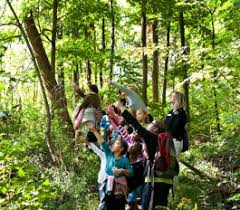The Discovery Walk
- The BIG Lesson
- Dec 1, 2023
- 3 min read
The Discovery Walk is a permanent fixture on Day 1 at Annie's BIG Nature Lesson, and for good reason. This walk, actually these TWO walks (one led by the teacher, the second led by the Naturalist), acquaints students with the landscape of the nature center and the trails they'll be returning to throughout the week. They are also an excellent opportunity to engage in the kind of learning that will happen throughout their ABNL experience: that of observation and inference. Dave Brigham wrote a beautiful handout on this very topic.
For students - and first time teachers - there is a great learning curve on discovery walks, not only in the landscape and the kinds of learning they'll be doing, but also in How to Be with nature. It seems that when the routine of daily school life changes, sometimes our students expectations about behavior also changes. As teachers, we know we have to be 1, 2, or 10 steps ahead of our kids to keep them safe and engaged. Here's some steps you could take, offered by the pros who make it look so easy, our ReWired teachers.
1. Do your homework. Ruth Pearson suggests walking the trails at the nature center you'll be attending with your students. It gives you familiarity with the landscape and the opportunity to experience what you'll soon be doing with your students. Cathie Wood adds, "If teachers do this, they can return to school the next day and hype up the experience, really get them excited, for their ABNL week."
2. Face the sun. Whenever possible, talk to your students while you're facing the sun, so they don't have to squint while looking at you.
3. Be the first. Often, students want to run along the trail, ahead of the group. Many teachers tell students they may be next to or behind the teacher while walking the trail. Jill Tribell has students rotate leading the pack in groups, so eventually everyone gets to be the leader at least once. For the occasional very insistent student who wants to run ahead, Roseann Dailey gives them a leadership role as "scout".
4. Enlist parent help. For those fortunate enough to have parent chaperones, assign at least to be the "caboose" (Stephanie Knapp is sure students still know what this word means!), and others to be interspersed throughout the middle of the group. Encourage them to model the behavior we want to see in our students, namely, staying off their phones, asking questions, and being active listeners.
4. Teach trail etiquette in advance. Before you go, remind students to stay on the trail and not take anything with them. By encouraging students to think of the natural area as the homes of so many creatures and critters, students can think about how they would want someone to behave in their own home.
5. Protect the tracks. Many times you'll stop along the trail to observe animal tracks or other interesting discoveries. To preserve the tracks so everyone can see them as they walk by, use a string to encricle them, and/or, have those eager students stand guard around them like Jan Derksen.
The discovery walk favors observation, curiosity, and conversation over distance, although you may find you cover quite a distance throughout the day! You can stop as frequently as you like along the trail, and you can read your students and the landscape for where, and how often to stop. Any way you slice it, there are a plethora of reasons to stop and tools to support students' engagement with the outdoors. See below for a gallery of ideas, or this handout for so many more.

























Бывают в жизни моменты, когда кажется, что всё идёт наперекосяк. Вот и у моего знакомого, назовём его Сергей, такой период затянулся на несколько лет. Работа не приносила удовольствия, отношения рассыпались, а деньги утекали сквозь пальцы. Он искал способ разорвать этот порочный круг, и однажды наткнулся на зеркало казино вавада.
Сначала он даже не понял, что это такое. Просто листал ленту в соцсетях, и вдруг мелькнуло это странное сочетание слов. Любопытство взяло верх, и он решил разобраться. Оказалось, что зеркало казино вавада — это не просто случайная фраза, а способ обойти блокировки и попасть на игровую платформу, даже если основной сайт недоступен. Сергей никогда не был азартным человеком, но в тот момент ему показалось, что это знак.
Он зарегистрировался, сделал первый…
Hi! 👍If you want to make your text stand out with a unique touch, try the small font tool by Creative Fabrica. This free generator converts your regular text into smaller, stylish characters that work well for social media bios, captions, or any digital content. It’s an easy way to add variety and catch attention across different platforms.
Using LinkBuilder has been a breeze and it’s really paid off. Their submission process is straightforward and has had a noticeable impact on my site's traffic. If you're like me and want results without the hassle, take a look at https://linkbuilder.com/submissions It’s definitely worth trying out.